Carbon Management Plan 2014
This revised Carbon Management Plan (CMP) sets out the activities that will enable us to reduce our carbon emissions and meet our reduction targets.
3. Emissions Baseline and Projections
Introduction
This section covers the emission sources that have been included within the SG carbon footprint boundary (energy, waste, water, transport and business travel), the emissions baseline for 2009/10, and the progress to date. It also forecasts the future carbon emissions and costs to demonstrate the impact on SG meeting its targets.
What is a carbon footprint?
A carbon footprint is an estimate of the annual climate change impact of an organisation. Typically, a carbon footprint is calculated by estimating not just the CO 2 emissions from an activity, but also any emissions of other greenhouse gases (such as methane and nitrous oxide). For simplicity, all these impacts are added together and expressed as a single number in units of carbon dioxide equivalent (CO 2e) which is the amount of CO 2 that would create the same amount of warming.
To calculate a carbon footprint, the organisation needs to collect activity data such as kWh of electricity used or business miles travelled or tonnes of waste produced. These are then multiplied using standard conversion UK factors to give an estimate of the tonnes of CO 2e produced from each activity.
Setting carbon footprint boundaries
Carbon footprints are defined in relation to two boundaries:
1) The operational boundary sets out which emission sources are to be included in the footprint. Based on the Greenhouse Gas Protocol ( WRI, 2004), this should include;
- All Scope 1 emissions - these are the direct emissions that an organisation is responsible for and include on-site fuel use e.g. natural gas, and fuel use in company owned vehicles;
- All Scope 2 emissions - these are indirect emissions caused by the generation of grid electricity; and
- Selected Scope 3 emissions - these are indirect emissions arising elsewhere from an organisation's activities e.g. emissions from air travel, waste disposal, water supply and treatment, and grid electricity transmission and distribution. These should be included where the organisation feels that they have sufficient control and are able to collect data to make an assessment.
2) The organisational boundary sets out which assets are to be included in the footprint and how any shared assets will be accounted for. The SG reports on its climate change impacts for a number of different reporting obligations, each of which has a different boundary.
Scottish Government CMP carbon footprint boundary
The changing nature of the estate, relating to both long-term asset management plans and shifting relationships between the SG and some executive agencies has created challenges for maintaining a consistent carbon footprint boundary. The SG began the Carbon Management Programme in May 2008, setting up a CMP covering the target period 2008/09 to 2013/14.
This original plan set a target of a 20% reduction by 2014 compared to the baseline footprint of 12,788 tCO 2e, measured in 2007/08. Sufficient projects were identified within the CMP to meet the target and processes for measuring and reporting the footprint were set up.
However, in April 2009, Marine Scotland was created and this not only increased the organisational boundary of the estate but also added a number of new emission sources, including the marine and jet fuel used in research and surveillance operations.
As a result, it was acknowledged that the CMP had to be updated, with respect to both the organisational boundary and the processes covered. It was also decided that these changes would require a reassessment of the previous plan's reduction targets to determine if they remained realistic.
During the process of revising the CMP, the boundary has been revised to make it consistent with the buildings included in the boundary for the Carbon Trust Standard.
The CMP carbon footprint boundary is shown in Figure 3.1.
Figure 3.1 - Revised Scottish Government CMP carbon footprint boundary.
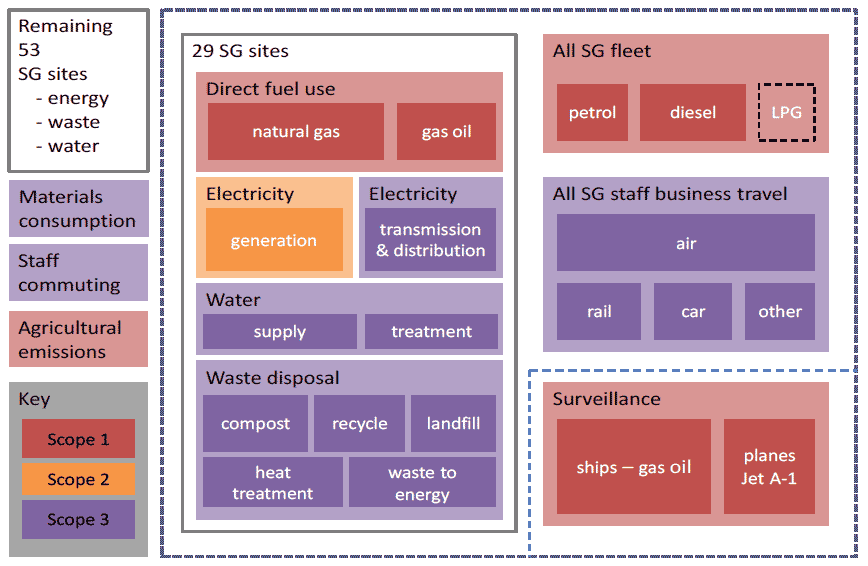
Boundary of SG CMP footprint
The estate boundary includes 29 SG sites representing over 97% of the total direct fuel use and electricity consumption. These buildings are identified as the most effective locations for implementing carbon reduction opportunities. The remaining 53 SG sites are outside the measured boundary because of the lack of metered consumption data available.
- Waste and water consumption are included for the same 29 buildings.
- Fleet travel is for all vehicles controlled directly by the SG and business travel is for all staff journeys. LPG was included in the baseline footprint (2009/10) and the footprint in 2010/11 but it is no longer used for fleet transport.
- The emissions from research and surveillance operations run by Marine Scotland have been included in the overall footprint, but should be seen as separate (represented in Fig. 3.1 by a dotted line) from the baseline for the purposes of forecasting and targeting.
There are a number of activities that are outwith the CMP carbon footprint boundary (materials consumption, staff commuting and agricultural activities are the key ones identified). These activities have been excluded due to difficulties in collecting accurate data and modelling emissions (agriculture) or lack of control over the emissions (commuting).
Data sources for the SG carbon footprint
The following list provides an overview of the activity data sources for calculating the carbon footprint. Further information on the carbon footprint methodology can be found in Appendix A.
Energy - automatic metering from the 29 major usage sites, including SASA and Marine Scotland research and science facilities.
Waste - annual waste figures taken from the management information collected by MITIE and recorded in the Public Sector Sustainability Report covering major sites.
Water - annual water figures taken from the management information collected by MITIE and recorded in the Public Sector Sustainability Report covering major sites.
Business Travel - figures are provided by our Travel Management Company and other smaller contracts for most business travel. Off-contract bookings are collected through our internal Travel & Subsistence process. Other information comes quarterly from Expotel, Arnold Clark, Central Taxis and T&S.
Transport - the mileage figures and fuel use recorded on the monthly log sheets of all official vehicles, including vehicles used by Marine Scotland and SASA, are collated and recorded on the fleet management database.
Research and Surveillance Operations - figures are provided by Marine Scotland for the fuel use for one aircraft and three marine vessels.
Conversion factors
In order to calculate the carbon footprint, consumption/activity data needs to be converted to units of tonnes CO 2e. This is done using standard factors issued by the UK Government for Company Reporting. These factors are reviewed centrally on an annual basis; some factors such as direct consumption units ( e.g. litres or kWh) of fossil fuels change very little because the amount of CO 2e produced when burned is very consistent. Others, such as grid electricity change on an annual basis depending on the exact grid composition reported by generators (this is influenced by factors such as weather, relative market prices for gas and coal etc). In order to make sure that the CMP carbon footprint is as accurate as possible, conversion factors should be checked and updated annually and the relevant factor from the reporting year applied.
2009/10 baseline and subsequent progress to date
The scale of change to the carbon footprint boundary has meant that the baseline year needed to be reset. The revised baseline year is 2009/10 and future targets and progress will be measured against this starting point. Table 3.1 shows the carbon footprint for the baseline year of 2009/10 and for the three subsequent years. It can be seen from Table 3.1 that the key sources of emissions are grid electricity consumption, direct fuel use and business travel. In the baseline year, research and surveillance accounts for over 50% of the total footprint and is therefore an important part of our climate change impact. However, it presents a problem in terms of setting targets because the emissions are closely related to research and surveillance activities and weather: In a year with poorer weather conditions and/or more extensive monitoring activities the increases in surveillance fuel consumption could reverse any reductions made by buildings or travel. The same could be true for marine research activities. Therefore, Marine Scotland research and surveillance fuels have been excluded from the footprint in terms of forecasting and target setting.
Table 3.1 - Breakdown of overall SG CMP carbon footprint 2009-14.
| 2009/10 | 2010/11 | 2011/12 | 2012/13 | 2013/14 | % change since 2009/10 |
||||||
|---|---|---|---|---|---|---|---|---|---|---|---|
| Emissions source | tCO2e | % | tCO2e | % | tCO2e | % | tCO2e | % | tCO2e | % | |
| Grid electricity | 12,895 | 59.9% | 12,657 | 59.0% | 11,490 | 59.0% | 11,561 | 56.0% | 10,763 | 57.3% | -16.5% |
| Direct fuel use (gas/gas oil) | 3,474 | 16.1% | 3,808 | 17.7% | 3,290 | 16.9% | 4,332 | 21.0% | 3,271 | 17.4% | -5.9% |
| Waste | 114 | 0.5% | 159 | 0.7% | 92 | 0.5% | 50 | 0.2% | 30 | 0.2% | -73.4% |
| Water | 74 | 0.3% | 94 | 0.4% | 123 | 0.6% | 120 | 0.6% | 68 | 0.4% | -8.1% |
| Fleet transport | 608 | 2.8% | 669 | 3.1% | 653 | 3.4% | 750 | 3.6% | 696 | 3.7% | 14.5% |
| Business travel | 4,350 | 20.2% | 4,072 | 19.0% | 3,812 | 19.6% | 3,816 | 18.5% | 3,949 | 21.0% | -9.2% |
| Sub-total | 21,515 | 100.0% | 21,459 | 100.0% | 19,461 | 100.0% | 20,629 | 100.0% | 18,777 | 100.0% | -12.7% |
| Surveillance | 20,367 | 48.6% | 17,105 | 44.4% | 17,073 | 46.7% | 17,131 | 45.4% | 16,047 | 46.1% | -21.2% |
| Overall total | 41,881 | 249% | 38,564 | 244% | 36,534 | 247% | 37,760 | 245% | 34,825 | 246% | -12.8% |
Figure 3.2 - Progress to date with SG CMP carbon footprint (excluding carbon emissions from Marine Scotland research and surveillance operations).
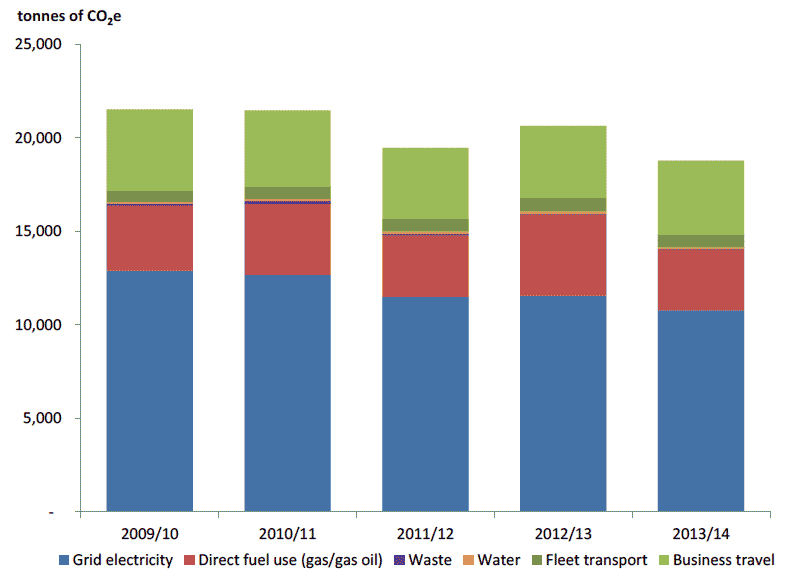
Table 3.2 shows the percentage change between the baseline year and most recent footprint year and provides a brief explanation of the reasons.
Table 3.2 -Change in footprint between baseline and most recent year.
| Emissions source | % change (2009/10 to 2013/14) | Reason |
|---|---|---|
| Grid electricity | -16.5% | Part of this decrease is due to a reduction in the carbon factor for grid electricity, which decreased by 9% between these two years. The remaining reduction is a combination of a rationalisation of the estate and the impact of projects across the estate. It is worth noting these savings take into account the consumption increase at Saughton House of 61% due to the increased level of use of the data centre. |
| Direct fuel use (gas/gas oil) | -5.9% | Part of the decrease is due to a reduction in the carbon factor for gas and gas oil, which decreased by 2.6% and 2.2% respectively. The remaining reduction is a combination of a rationalisation of the estate and the impact of projects across the estate. It is worth noting these savings take into account the consumption increase at Marine Lab of 53% due to Ellis Building coming online. |
| Waste | -73.4% | A slight increase in waste tonnage has been more than compensated by improved segregation and recycling of waste, resulting in lower carbon emissions per tonne of waste produced. |
| Water | -8.1% | Water consumption is highly influenced by the scientific activities at Marine Laboratory and 2013-14 was a year of very low use at this site. This may not be replicated in future years. There has been an increase of around 15% in the carbon conversion factors for water supply. |
| Fleet transport | +14.5% | A rationalisation exercise and further investment has helped to reduce the overall carbon impact of the whole fleet. |
| Business travel | -9.2% | A culture change across the organisation, where staff avoid travel or choose lower carbon options, in part due to the availability of better internal conferencing facilities, has contributed towards a reduction in travel-related emissions. There has been a slight decrease in the carbon emission factors for air travel over this time. |
| Overall change | -12.8% |
How will the Scottish Government carbon footprint change in the future?
In order to set a realistic and achievable carbon reduction target, it is important to know what the likely trend of the carbon footprint would be in the future, if no specific action were taken to reduce it, the 'business as usual' ( BAU). This forecast helps the organisation to predict how much carbon would need to be saved annually to meet the future target and therefore assess if this is realistic. The future SG carbon footprint has been predicted by looking at the range of factors that could influence different emission sources within the footprint. The factors that have been included in the forecast are discussed below. More detail about the method used to estimate the future BAU footprint can be found in Appendix B.
Grid electricity - 3 factors have been included to forecast future emissions from grid electricity. Two of these are internal:
1) Reduction in the size of the core estate by 25% by 2016 will result in some buildings being taken out of the footprint and some staff movements to other buildings, resulting in changing patterns of consumption at different buildings
2) At the same time, there is forecast to be an annual growth in intensity of electricity consumption for IT and other equipment (estimated at 1% per year)
The third factor is external - the carbon intensity of the National Grid (measured in kg of CO 2 per kWh) is expected to decrease as more renewable energy is generated and also as existing coal-fired plant is retired due to the implementation of the Large Combustion Plant Directive. A cautious projection has been used to model the impact of the decarbonisation of the grid.
Direct fuel use (gas/gas oil) and water - direct fuel use will be affected by the strategy to reduce the size of the core estate by 25% by 2016 - as with electricity, there are likely to be changing patterns of consumption at different buildings.
Waste and business travel & transport fleet - emissions generated by staff activity will be affected by reduction in administration costs by at least 20%, however, the exact nature of the changes is not yet known and therefore this is currently left out of the BAU scenario.
Table 3.3 shows the baseline carbon footprint emissions next to the forecast emissions in 2019/20. This table shows that the emissions are forecast to reduce for all emission sources within the footprint, apart from water. It is recognised the baseline year of 2009/10 for water is not representative of the subsequent years: consumption of water increased significantly in 2010/11 due to the use of mains water, rather than sea water, for the Marine Scotland aquarium at the research facility at Torry in Aberdeen. The overall reduction in emissions is mostly due to forecast reductions in consumption, however decarbonisation of the grid provides an additional element to the forecast reduction in emissions from electricity use.
Table 3.3 - Forecast BAU for the SG CMP carbon footprint.
| Emissions source | Estimated emissions (tCO 2e) | % between 2009/10 and 2019/20 (%) |
|
|---|---|---|---|
| 2009/10 | 2019/20 | ||
| Grid electricity | 12,895 | 12,770 | -1.0% |
| Direct fuel use (gas/gas oil) | 3,474 | 3,125 | -10.1% |
| Waste | 114 | 92.3 | -18.7% |
| Water | 74 | 123.4 | 66.0% |
| Business Travel & Fleet | 4,958 | 4,348 | -12.3% |
| Total | 21,515 | 20,458 | -4.9% |
Figure 3.3 shows the forecast trend in emissions for the 'Business as Usual' ( BAU) scenario over the time period of the CM plan. The graph shows that from 2014/15 onwards the trend is almost static; although underlying this trend there are some factors that will tend to increase the carbon footprint and others that will tend to push it downwards; the overall net effect is to keep the BAU footprint fairly constant.
Figure 3.3 - Forecast trend in carbon emissions for the BAU scenario.
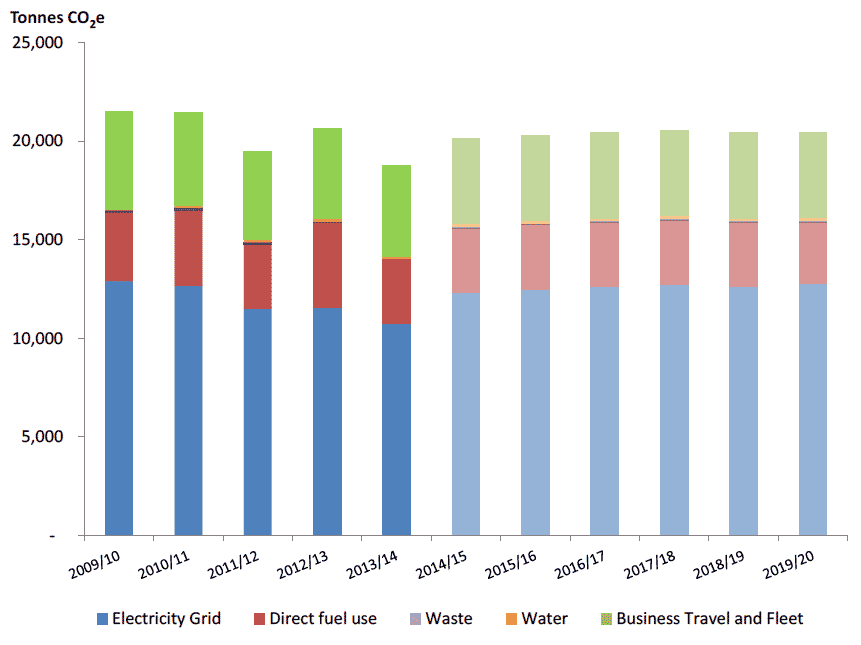
Utility cost and expenditure forecast
The forecast emissions from the various sources were used in combination with unit price forecasts to develop a utility cost and expenditure forecast for the 'Business as Usual' scenario. Table 3.4 shows how the SG expenditure on utilities and business travel is predicted to change between 2009/10 to 2019/20. This table shows that overall spend is likely to increase because prices are forecast to rise faster than consumption will decrease.
Overall, the price increase is estimated to be around 17% over the 11 year period; however, there is a great deal of variation between different areas, for example electricity expenditure is predicted to increase by 28% whereas expenditure on business travel is only predicted to increase by 11%.
Table 3.4 - Forecast BAU for the SG CMP utility costs.
| Utility/other expenditure | Estimated spend (£ million) | Change between 2009/10 and 2019/20 (%) |
|
|---|---|---|---|
| 2009/10 | 2019/20 | ||
| Grid electricity | 3,053 | 3,906 | 28% |
| Direct fuel use | 717 | 619 | -14% |
| Waste | 122 | 258 | 112% |
| Water | 76 | 132 | 75% |
| Business Travel & Fleet | 4,880 | 5,435 | 11% |
| Total | 8,847 | 10,350 | 17% |
These costs include additional obligations such as the CRC which adds, at current prices, £12 per tonne of emissions for both grid electricity and direct fuel use. Figure 3.4 shows how utility/business travel expenditure is forecast to increase between 2009/10 and 2019/20. This graph shows the relative importance of minor emissions sources as proportions of the total cost - waste, water and transport are jointly responsible for only 24% of the total annual carbon emissions, but 57% of the total annual cost.
Figure 3.4 - Forecast trend in utility cost for the BAU scenario.
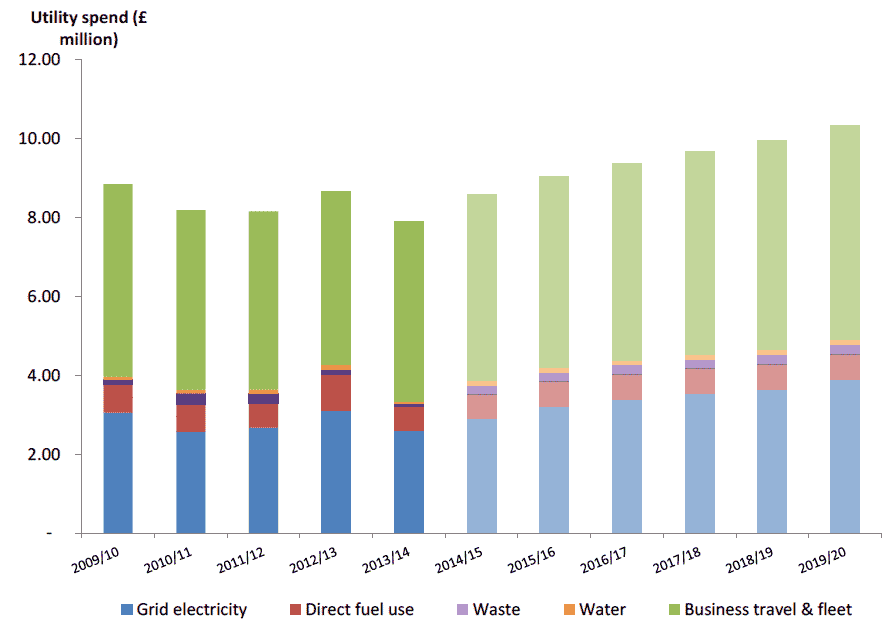
Value at Stake of the Carbon Management Plan target
In order to work out the Value at Stake ( VAS) of the planned investment, the annual carbon savings from the projects described in Section 4 have been 'added' to the BAU scenario (because the projects produce savings, the net effect is to lower the predicted emissions).
This is shown in Figure 3.5 below, which demonstrates the forecast carbon footprint for SG if all the carbon reduction projects are successfully implemented. The blue line shows the target of 15% by 2014/15 and 30% by 2019/20. This graph shows that there should be sufficient projects identified to meet, and potentially exceed, the interim carbon target in 2014/15, but further projects will need to be identified and implemented in order to meet the longer term 30% target in 2019/20.
Figure 3.5 - Forecast CMP footprint with all carbon reduction projects implemented.
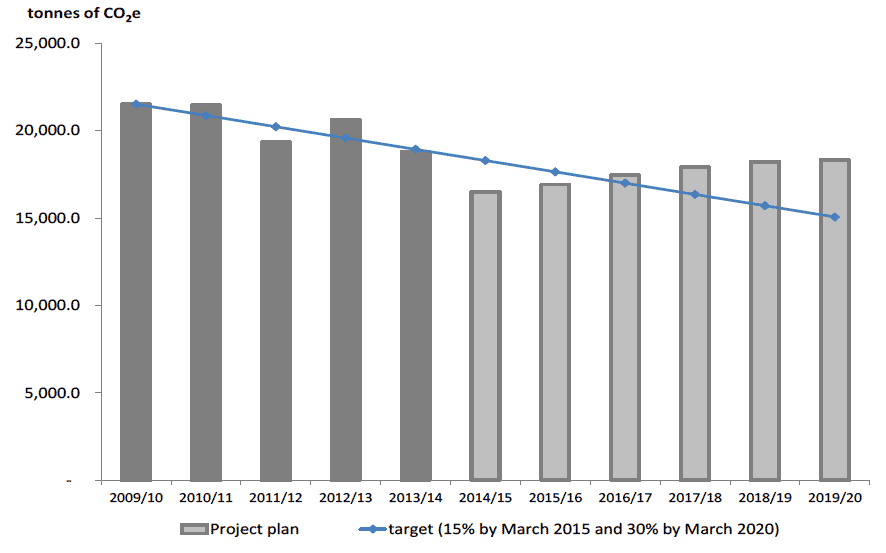
The final graph in this section shows the forecast utility and business travel spend for following three scenarios:
1) The Business as Usual scenario, where the SG does not invest in specific carbon reduction opportunities and therefore no action is taken to implement identified projects;
2) The CMP project scenario, where current list of carbon reduction opportunities is implemented successfully; and
3) The Carbon reduction target scenario, where the Scottish Government successfully implements existing and future carbon reductions in order to meet the 30% reduction target in 2019/20.
Figure 3.6 - Forecast utility and business travel spend for three scenarios.
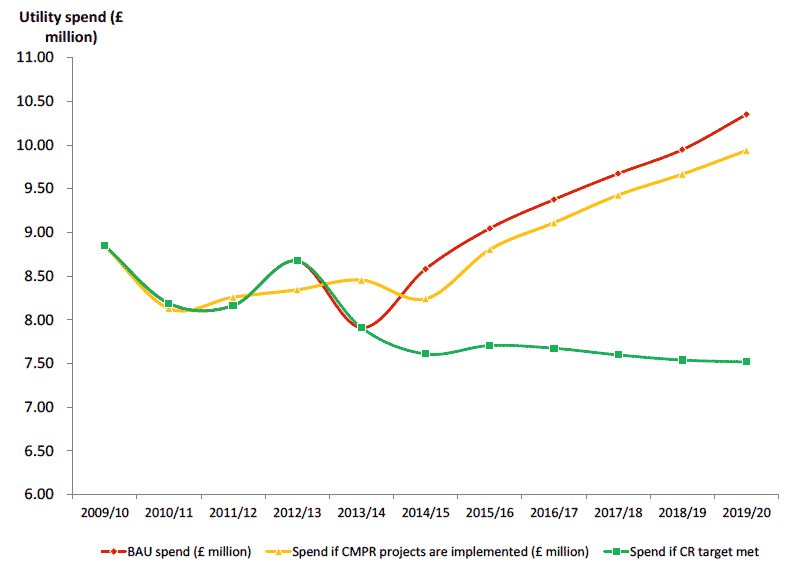
The 'Value at Stake' is calculated as the area gap between the BAU scenario and either the CMP project scenario or the carbon reduction target scenario. The total VAS for the whole target period is shown in table 3.5 below.
Table 3.5 - Value at Stake based on different scenarios.
| CM Plan project scenario compared to BAU | CM Plan target scenario compared to BAU | |
|---|---|---|
| Carbon Value At Stake (total tCO 2e) | 20,730 | 22,678 |
| Utility/business Travel spend VAS (total £) | £3,831,000 | £13,233,000 |
Therefore, it is estimated that by implementing the existing CMP project list, the SG will avoid expenditure of £3.8 million over the next six years, as well as reducing total emissions by over 20,000 tCO 2e. If the CMP targets are met, through the identification and implementation of additional projects, these figures should increase to over £13 million and over 22,000 tCO 2e.
These figures demonstrate how the CMP offers good value for money in terms of investment and helps tackle climate change. Delays in the predicted implementation dates currently recorded in the CMP Register will negatively affect any future cost avoidance forecasts.
Contact
There is a problem
Thanks for your feedback